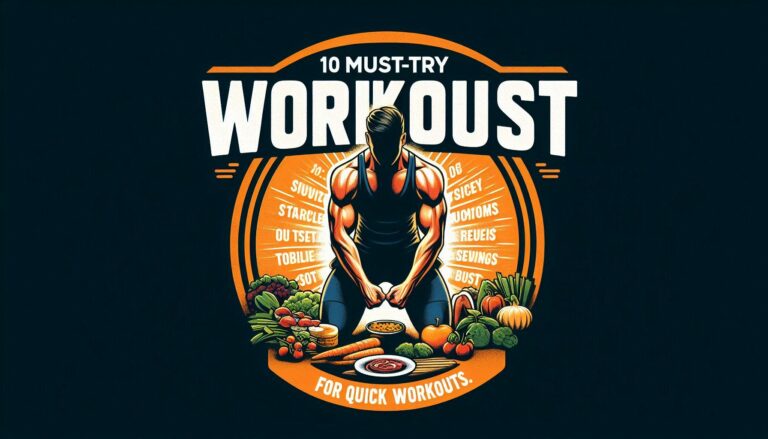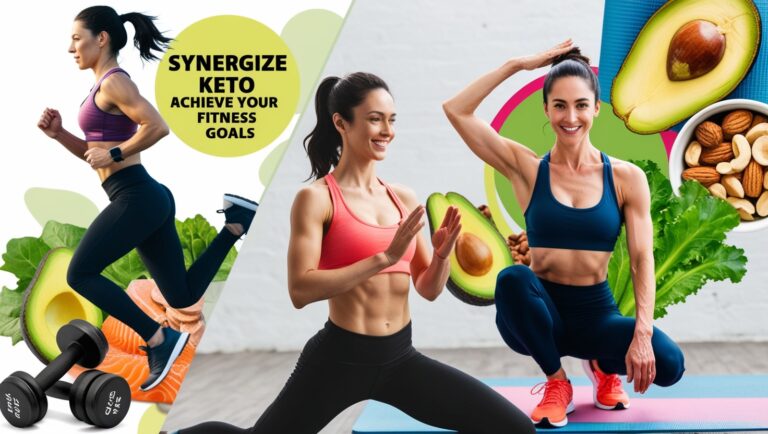Simplifying Keto Meal Plan Basics: A Beginner’s Guide

What is a keto meal plan?
A keto meal plan is a low-carb, high-fat diet designed to shift the body’s metabolism away from carbs and towards fat and ketones. It involves reducing carbohydrate intake and replacing it with healthy fats, leading to a state of ketosis where the body burns fat for energy.
What is a keto meal plan?
A Keto meal plan is a structured diet that focuses on high-fat, moderate-protein, and low-carb foods. It aims to trigger a metabolic state called ketosis, where the body burns fat for energy instead of carbohydrates. This can lead to weight loss and improved overall health when followed correctly.
Key Highlights
- The keto diet is all about eating more fats and fewer carbs, which can help you lose weight and feel better overall.
- By getting your meals ready ahead of time, sticking to a keto meal plan becomes much simpler.
- Knowing the basics, like what ketosis means and how macros work, is important if you’re doing the keto diet.
- Having the right tools and ingredients in your kitchen makes preparing keto meals both easier and more fun.
- Figuring out your macros and knowing which foods fit into a keto diet are key steps for tailoring a meal plan that works for you.
- Using a detailed guide can assist in setting goals for your ketogenic journey, planning out what to eat, and incorporating intermittent fasting techniques effectively.
Introduction
The keto diet, also known as the ketogenic diet, is becoming popular all over for losing weight and getting healthier. It’s all about eating more fats but fewer carbs to get your body into ketosis. When you’re in ketosis, your body uses fat instead of carbs for energy, making it a popular diet for weight loss and other health benefits. However, it’s important to note that the keto diet was originally developed in the 1920s as a way to treat childhood epilepsy, and it is still used for that purpose today. According to a 2023 Scientific Reports article, the keto diet can reduce seizures in children by up to 90%, making it a valuable treatment option for those with epilepsy.
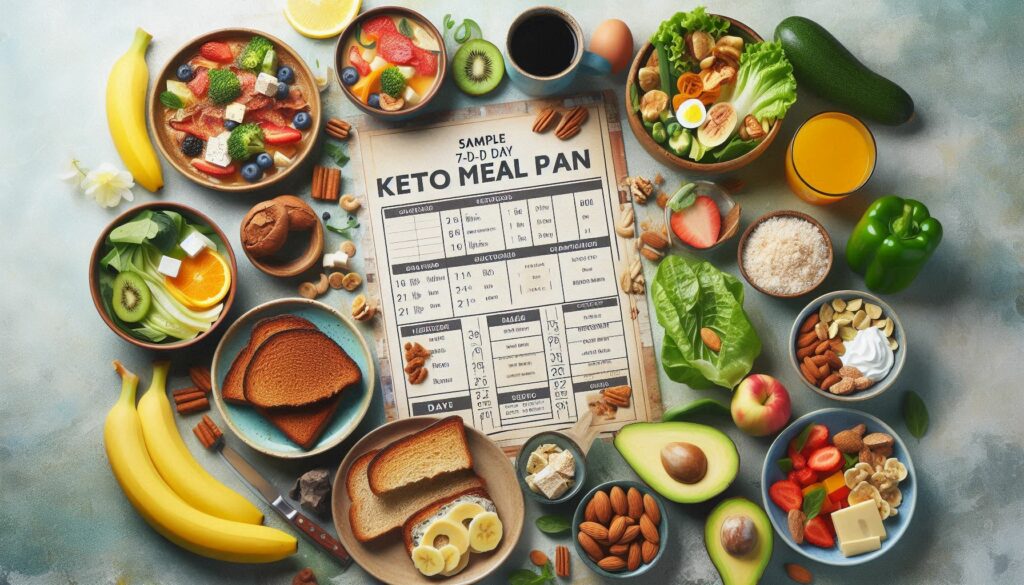
Starting a keto meal plan is an awesome way to kick off your journey towards losing weight and feeling better overall. By choosing meals rich in healthy fats, with a good amount of protein and a few carbs from veggies, you’ll make tasty dishes that keep hunger away all day long.
In this guide made just for beginners on making a keto meal plan, we’ll cover what the ketogenic diet is about at its core. We’ll share some advice on how to get ready for starting with keto, show how to figure out your macros (that’s short for macronutrients) and walk through putting together a new diet that fits just right with what you need personally. Whether it’s new territory or if you’re looking to shake up how you’ve been planning meals while keeping it keto-friendly – this guide aims at making everything easier so success feels within reach.
Understanding the Keto Diet
The keto diet is all about eating lots of healthy fats and cutting down on carbs. This way, your body switches from using glucose for energy to burning fat instead, which can help you shed some pounds. By sticking to this plan and reducing how many carbs you eat, you enter a state known as ketosis. When in ketosis, your body gets good at melting away fat for fuel, typically within the first week of following the diet. So basically, the ketogenic diet not only helps with weight loss but also boosts overall health by making these changes in what you eat.
What is the Keto Diet?
The keto diet is all about eating a lot of fat, very few carbs, and a moderate amount of protein. It’s designed to get your body into ketosis, which is the state of burning fat for energy instead of glucose from carbs. By following a keto diet plan, you can restrict your carbohydrate and glucose intake, forcing your body to enter ketosis. While there are different versions of the keto diet, this basic plan can be altered to fit your lifestyle needs and preferences.
With the keto diet:
- You get 70-75% of your calories from fat.
- Protein makes up 15-20%.
- Only 5-10% come from carbohydrates.
This mix helps shift your body into relying on fat for its main source of fuel which leads to dropping pounds and feeling more pep in your step.
How the Keto Diet Works
When you stick to a keto diet and cut down on carbs, your body turns to burn stored fat for energy by making ketones. Ketones are made in the liver when there’s not much glucose around. They become an alternative fuel source for your body.
Usually, our bodies get their energy from glucose found in carbs. But if you eat less of those and more fats instead, your body shifts to using fat as its go-to energy source. This change can help burn off more fat and lead to weight loss.
By getting into ketosis, where your body is good at using fat for power, you might notice better energy levels, fewer hunger pangs or cravings, and an even greater ability to burn through fat.
Preparing for Your Keto Journey
Before starting your keto adventure, it’s crucial to get ready and make sure you’re set for a win. This means filling up your kitchen with all the necessary tools and stuff you’ll need, along with getting the hang of what the keto diet is all about.

Essential Kitchen Tools and Equipment
To make preparing keto meals simpler and more fun, it’s important to have the proper gear in your kitchen. Here are a few must-haves:
- With a sheet pan, you can easily roast meats and low-carb veggies.
- Olive oil is great for both cooking and adding flavor to salads because it’s tasty and good for you.
- Cauliflower rice serves as an excellent low-carb substitute for regular rice, making it super versatile.
Basic Ingredients for a Keto Pantry
To whip up tasty and healthy meals, it’s key to fill your pantry with keto-friendly stuff. Here are a few must-haves:
- Almonds: These make for a great snack on the go, packed with healthy fats and protein.
- Coconut oil: This is super flexible in the kitchen, and good for both cooking and baking.
- Green beans: With these low-carb veggies, you can stir-fry or roast them to make a delicious side dish.
- Pork rinds: For when you’re craving something crunchy without the carbs but still want some protein.
The Beginner’s Guide to Keto Meal Planning
Planning your meals ahead of time is super important when you’re sticking to a keto diet. With this approach, you make sure that there are always healthy and suitable choices available for your diet. This can help in keeping you focused on your journey towards losing weight and hitting those goals.
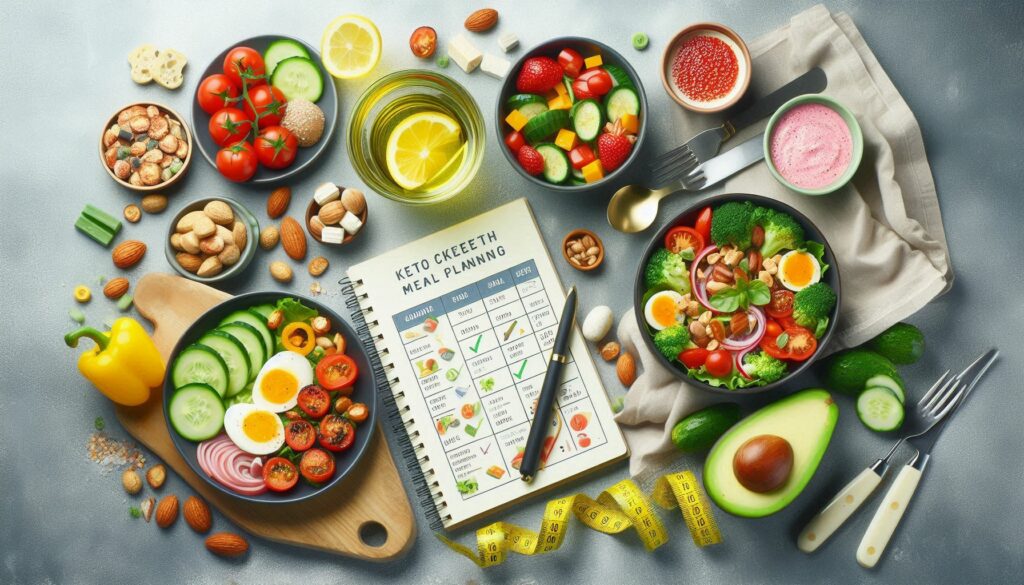
Calculating Your Macros
Figuring out your macros is a key part of making a meal plan that’s just for you, especially if you’re following a keto diet. Macros are the big nutrients: how many carbs, proteins, and fats you need to eat every day.
To start calculating these macros, first figure out how many calories you should be eating each day. Then work out your total carb limit and how many grams of carbs fit into each meal. This step helps in putting together a diet plan that not only meets your weight loss goals but also keeps your body in ketosis by restricting carb intake.
Understanding Keto-Friendly Foods
To make a good meal plan for keto, it’s key to know which foods fit the bill. You should go for veggies that don’t have many carbs, fats that are good for you like avocado and coconut oil, and fruits low in sugar such as berries. For stuff like bread and pasta that’s high in carbs, try using things like cauliflower rice or noodles made from zucchini instead. Using dairy alternatives such as almond milk or yogurt made from coconut can also be part of your keto diet. Additionally, cereals are not recommended on a keto diet as they are high in carbs. By adding these kinds of keto-friendly foods to what you eat, you’ll be able to whip up meals that are both tasty and healthy while keeping yourself in ketosis.
Step-by-Step Guide to Creating Your Meal Plan
To really stick to a keto diet and see good results, making your own meal plan is crucial. With a step-by-step guide in hand, you can figure out what you want to achieve, organize your meals accordingly, and even mix in some intermittent fasting methods for the best outcome.
Step 1: Setting Your Keto Goals
Before you start putting together your keto meal plan, it’s crucial to know what you’re aiming for. Are you looking to shed some pounds, tackle obesity, or just want to boost your health? Setting a clear goal will keep you driven and on track with your keto path. These goals are within reach and not too far-fetched. Think about how sticking with a keto diet can pay off in the long run.
Step 2: Planning Your Meals Around Your Macros
After figuring out your macros, it’s time to map out your meals. With an emphasis on healthy fats, a good amount of protein, and veggies that are low in carbs, try to mix things up with keto-friendly foods. Using meal prep as a tool can help you stick to those macro goals and steer clear of not-so-great food options. By getting your meals ready ahead of time, you make sure there’s always something nutritious and in line with the keto diet waiting for you all week long.
Step 3: Incorporating Intermittent Fasting Techniques

Intermittent fasting can boost how well a keto diet works. When you mix in methods like eating only during certain hours or fasting every other day, it helps your body get into ketosis faster and burn fat more efficiently. By choosing to eat within specific times, you’re also naturally cutting down on calories since there’s less time for snacking and meals. But remember, it’s crucial to pay attention to what your body is telling you and talk with a doctor before diving into any kind of fasting plan alongside your keto diet.
Step 4: Shopping for Keto-Friendly Foods
Shopping for keto-friendly foods is an essential step in following a ketogenic diet. Having a well-prepared shopping list can help you make healthier choices and avoid high-carb temptations while grocery shopping. Here is a suggested keto shopping list to guide you:
| Keto-Friendly Foods |
|————————–|—————————————————————–|
| Meat and poultry | beef, chicken, turkey, pork |
| Fish | salmon, herring, mackerel, tuna |
| Eggs | pastured, organic, or conventional |
| Full-fat dairy | unsweetened yogurt, butter, cream |
| Cheese | cheddar, mozzarella, brie, cream cheese |
| Nuts and seeds | macadamia nuts, almonds, walnuts, pumpkin seeds |
| Nut butter | no-sugar-added peanut, almond, cashew butter |
| Oils rich in healthy fats | olive oil, avocado oil, sesame oil |
| Avocados | whole avocados |
| Non-starchy vegetables | greens, broccoli, tomatoes, mushrooms, peppers |
| Condiments | salt, pepper, vinegar, lemon juice, herbs, spices |
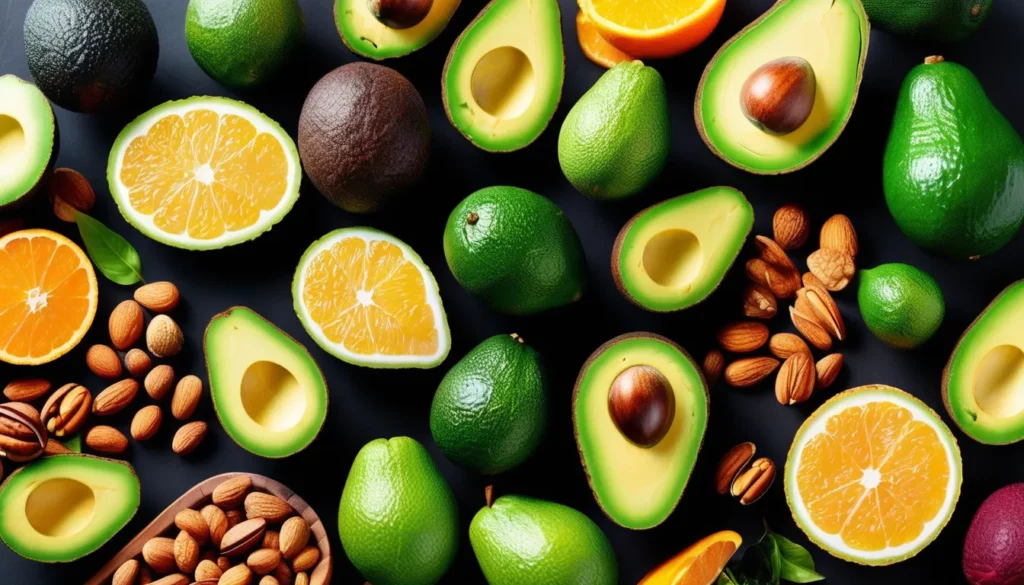
Including these foods in your shopping list is a great way to ensure you have a variety of keto-friendly options for your meals and snacks. For example, you can make a delicious tuna salad using canned tuna, mayonnaise, celery, and salt and pepper. These ingredients are readily available and can be included in your weekly shopping list for long-term success on the keto diet.
Step 5: Prepping and Cooking Your Meals
Getting your meals ready and cooking them is key when you’re following a keto diet. When you prepare your food ahead of time, it’s easier to have good-for-you, keto-friendly choices on hand and dodge the temptation to eat something on impulse. Here are some pointers for getting your keto meals prepped and cooked, including delicious dinner recipes:
- Start with picking out low-carb veggies like cauliflower, broccoli, and spinach for the foundation of what you’ll be eating. These veggies pack in nutrients and work great in lots of different recipes that fit into a keto diet.
- For cooking or adding extra taste to what you make, go with healthy fats such as olive oil. Fats like these are crucial for keeping up with the keto plan because they help fill you up.
- Try out various ways to cook things—like roasting, sautéing, or grilling—to keep flavors interesting without piling on carbs that aren’t part of the meal plan.
- Organize what you’re going to eat throughout the week by planning and dividing everything into portions before needing them can really simplify sticking with your goals during hectic days.
- -With tools like slow cookers or Instant Pots at home making big batches becomes even simpler so there’s always something tasty waiting.
By doing all this prep work beforehand ensures staying true to those ketogenic guidelines while never running short on yummy options available anytime!
Step 6: Tracking Your Progress
Keeping tabs on your journey is key when you’re following a keto meal plan. It’s all about being responsible and watching how things are going for you. Here’s what you can do to keep an eye on your progress with the keto diet:
- By maintaining a food diary, jot down everything that goes into your mouth. This helps in monitoring how many carbs you’re consuming and makes sure it aligns with what you’ve planned.
- With the help of tracking apps or websites tailored for those on a keto diet, keeping track of macros, calories, and how far along you’ve come becomes easier. These platforms often throw in some cool recipe ideas and meal plans too.
- Taking measurements isn’t just about stepping onto the scale; measure around your waist, hips, etc., as well because sometimes numbers don’t change much there but they do elsewhere which shows progress.
- During the initial week especially pay close attention to any changes happening within like feeling tired more than usual or getting headaches – these could be signs of the so-called “keto flu”. While these feelings might go away after some days if they stick around longer maybe it’s time to rethink parts of your meal strategy.
By doing this kind of tracking work regularly allows room for tweaking bits here and there in your eating habits ensuring motivation levels stay high throughout this dietary adventure called keto.
Keto Recipes to Get You Started
To keep on the right path and enjoy your journey, it’s crucial to have a bunch of tasty yet simple keto recipes in your meal plan. Here are some keto recipes to kick things off:
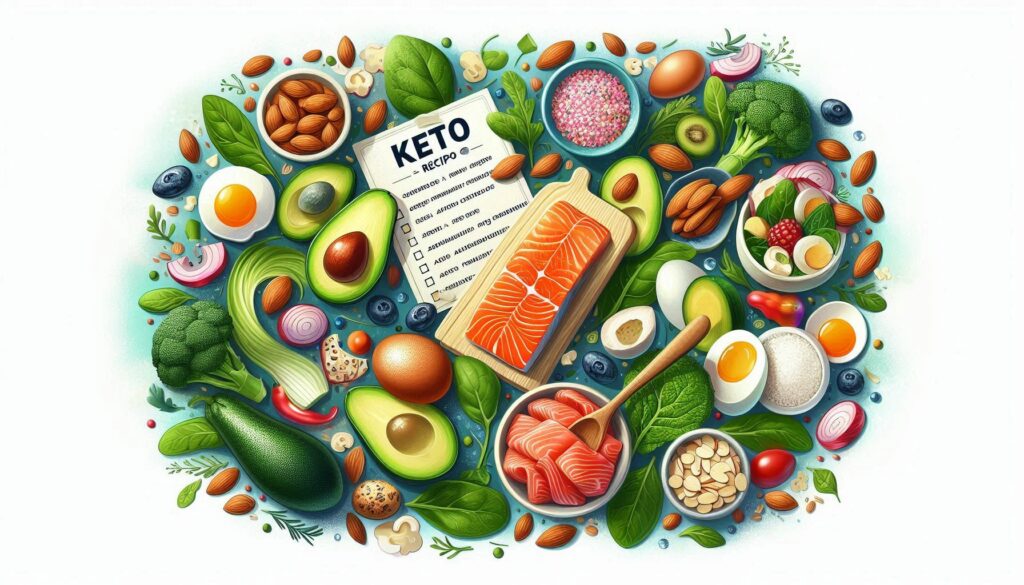
Breakfast Ideas for a Keto Diet
- For a keto breakfast, you can’t go wrong with scrambled eggs mixed up with some bacon or veggies.
- With mushrooms, cheese, and spinach, whipping up a keto omelet is another tasty choice.
- Kicking off your day with an avocado and spinach smoothie is a great way to get those healthy fats and nutrients in.
- If you’re craving something sweet, almond flour pancakes topped with sugar-free syrup and berries make for a delicious meal without breaking your keto diet.
- Starting the morning with bulletproof coffee—coffee blended with butter and MCT oil—is quite popular among those following the keto lifestyle.
Quick and Easy Keto Lunches
- With mayo, celery, and pickles mixed in, tuna salad tastes great on some lettuce or wrapped up in it.
- For a low-carb lunch, try zoodles with either pesto or marinara sauce. Zoodles are just zucchini turned into noodle shapes.
- Wrapping sliced turkey or chicken along with bacon, avocado, and mayo in lettuce makes for an easy and tasty keto meal idea.
- Cobb salads packed with things like hard-boiled eggs, bacon, avocado, and blue cheese offer a hearty option that’s good for you too.
- A classic choice is the Chicken Caesar salad. It comes with grilled chicken over romaine lettuce topped off with Parmesan cheese and a dressing that fits right into a keto diet.
These ideas can help kick-start your keto meal plan by mixing them up to match what you like eating while sticking to your dietary goals.
Overcoming Common Keto Challenges
Sticking to a keto diet isn’t always easy, but with the proper attitude and some smart tactics, you can tackle its challenges. Let’s talk about what makes the keto diet tough for some folks and share tips on how to deal with these issues:

- With keto, getting used to eating very few carbs is hard at first. But by focusing on all the tasty fats and proteins you can eat instead, it gets easier.
- On this diet, many miss their favorite sugary snacks. A good workaround is finding low-carb alternatives that satisfy those cravings without breaking your carb limit.
- Sometimes people feel tired or have headaches when they start keto because their body is adjusting. Drinking plenty of water and making sure you’re getting enough electrolytes helps a lot.
- Eating out or going to social events can be tricky since not everything fits into a keto lifestyle. Planning ahead by checking menus online or bringing your snacks can save the day.
By keeping these strategies in mind, sticking with a keto plan becomes more manageable over time.
Managing Keto Flu Symptoms
- When you start the keto diet, it’s pretty common to feel under the weather with what’s known as the keto flu. This includes feeling tired, getting headaches, and being cranky. To deal with these issues, it’s important to drink lots of water and eat foods that are high in electrolytes like avocados and spinach. These steps can help make those symptoms less bothersome.
- By slowly cutting down on carbs rather than stopping all at once, your body can get used to this new way of eating more easily.
- Making sure you’re getting plenty of sleep and keeping stress low is also key during this switch to ketosis since both sleep quality and stress levels play a big role in how you feel throughout this process.
Staying Keto on a Budget
- Sticking to a keto diet doesn’t mean you have to spend a lot of money. By planning your meals and creating a shopping list, you can steer clear of buying things on the fly. Purchasing items in large quantities is also smart, especially when it comes to non-perishable foods that fit the keto plan like nuts and seeds.
- Preparing your meals beforehand is an excellent strategy for both saving time and cutting costs. Cook up big portions of food that are good for your keto journey and divide them into servings for each day of the week. This helps keep you from dining out too much and makes sure there’s always something healthy to eat.
With some foresight and action, navigating through common hurdles while following a keto lifestyle becomes manageable, keeping you aligned with your health improvement objectives as well as aiding in weight loss efforts
Maintaining Your Keto Lifestyle
Once you get into ketosis and get used to the keto diet, keeping up with your keto lifestyle is key to keep enjoying its perks. To help you stick with your keto way of life, here are a few steps:
- With the keto diet being part of your routine now, it’s crucial not to fall back into old eating habits.
- Staying in ketosis means paying attention to what you eat every day so that you don’t accidentally slip out of it.
- Making sure your meals align with the keto guidelines will ensure that all the hard work pays off in maintaining this lifestyle.
Adjusting Your Meal Plan as Your Body Adapts
- When you’re on the keto diet, your body gets used to it after a while. Because of this, you might have to change what you eat a bit. This can mean playing around with your macros, eating more or fewer calories, or trying out intermittent fasting.
- Think about adding carb cycling to what you eat. It’s when you switch between days where you eat lots of carbs and days where you don’t eat many. This gives your body different kinds of energy.
- Keep checking in on how close you are to reaching your goals and see if there’s anything that needs changing in either what you’re eating or how else you’re living life.
Incorporating Exercise into Your Keto Routine

- Keeping up with regular workouts is key to staying healthy while on the keto diet. It boosts your energy, helps you lose weight, and makes you feel great overall.
- With exercise, go for what makes you happy and fits your health goals. You might like lifting weights, doing some cardio or even taking it easy with yoga.
- Pay attention to how energetic you feel and tweak how hard you push yourself in workouts if needed. When starting on keto, some folks find they’re not as strong or fast as usual but this often gets better.
- Drinking plenty of water and making sure your body has enough electrolytes before, during, and after working out is crucial to keep hydrated without messing up your electrolyte balance.
By tweaking what’s on your plate alongside keeping active regularly when following a keto lifestyle can help ensure it’s both healthy and something you can stick with long-term.
Conclusion
Starting a keto meal plan is both thrilling and beneficial. It’s important to get the basics right, such as figuring out your macros and adding in some intermittent fasting, for it to work well. By being careful with planning, buying foods that fit the keto diet, and keeping an eye on how you’re doing, you’re setting yourself up for long-term success with this lifestyle. Facing hurdles like dealing with symptoms of the keto flu or sticking to your budget is all part of the journey. As things move along, adjusting what you eat based on changes in your body and making sure exercise is part of your routine are crucial steps. With clear goals and a systematic way of approaching it, enjoying all that comes from following a thorough keto diet becomes possible.
Frequently Asked Questions
How Long Should I Stay on the Keto Diet?
On the keto diet, how long you should stick with it depends on what you’re hoping to achieve and your personal health requirements. For some folks, adopting the keto lifestyle is a permanent change they’re happy to make. Others might see it as just a temporary method for shedding some pounds. It’s crucial to pay attention to how your body reacts and tweak things if necessary.
